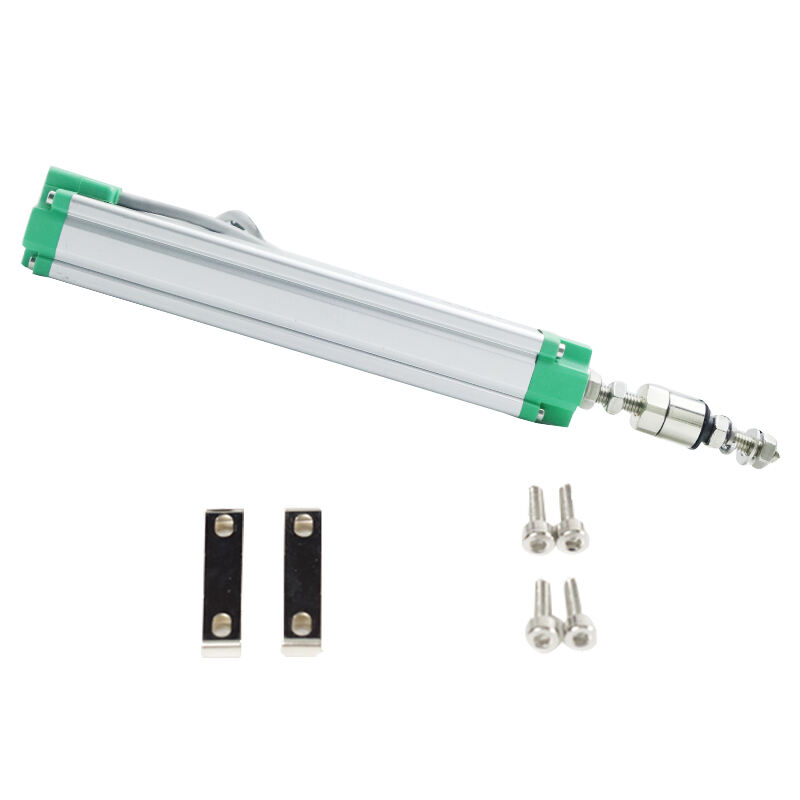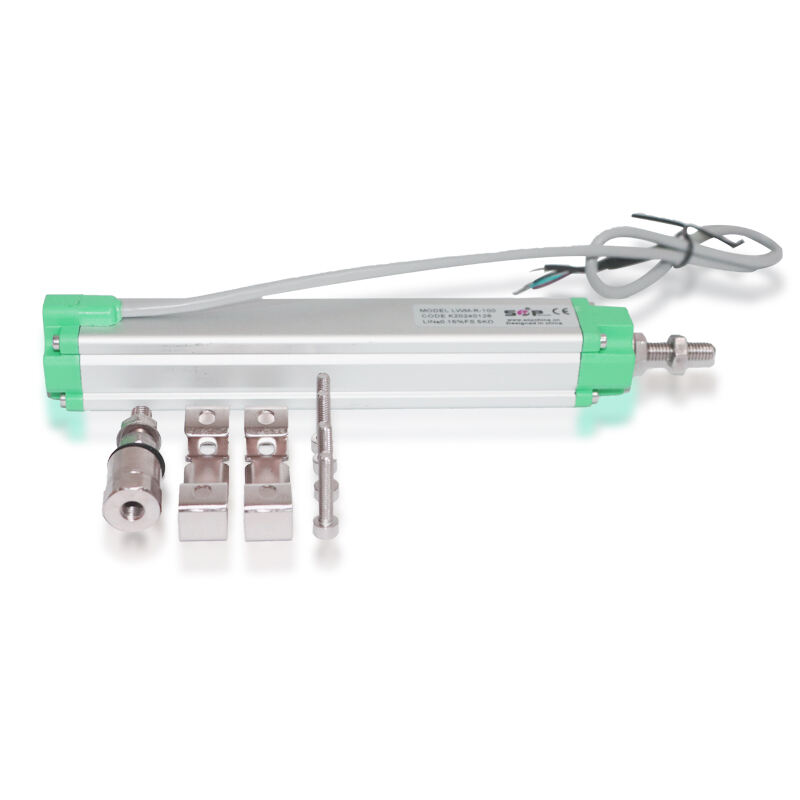ข้อได้เปรียบหลักของการบูรณาการแบบไร้สายในเซนเซอร์การเลื่อนเชิงเส้น
การส่งข้อมูลแบบเรียลไทม์โดยไม่มีข้อจำกัดทางกายภาพ
เทคโนโลยีไร้สายที่ถูกรวมเข้าไว้ในเซนเซอร์การกระจัดเชิงเส้นช่วยให้มีการส่งข้อมูลแบบเรียลไทม์ ซึ่งเพิ่มประสิทธิภาพในการดำเนินงานโดยรวม เซนเซอร์เหล่านี้สามารถเพิ่มประสิทธิภาพได้มากถึง 30% โดยการตอบสนองต่อข้อมูลจากเซนเซอร์แบบเรียลไทม์ การพัฒนานี้ลบล้างข้อจำกัดทางกายภาพที่เกิดจากสายเคเบิลออก ทำให้สามารถติดตั้งได้ในสถานการณ์ที่ท้าทายหรือไม่ปลอดภัย เช่น การก่อสร้างอาคารที่มีผนังและเพดานห่างกันถึง 6 วันระหว่างตัวส่งและตัวรับ หรือต้องการโซลูชันจุดต่อจุดที่ได้รับการประเมินระดับ Class I Div 1 ความสามารถนี้มีความสำคัญสำหรับแอปพลิเคชันที่ต้องการการตรวจสอบอย่างต่อเนื่อง ในขณะเดียวกันยังมีสภาพแวดล้อมที่หลากหลาย เช่น อุตสาหกรรมอัตโนมัติหรือการติดตามทางธรณีวิทยา นอกจากนี้ การบูรณาการเทคโนโลยีไร้สายยังช่วยให้สามารถใช้งานได้ในสถานการณ์ที่เปลี่ยนแปลงตลอดเวลาและมีความซับซ้อน ซึ่งอาจเป็นอุปสรรคสำหรับโซลูชันแบบมีสาย และยังทำให้เทคโนโลยีนี้มีความได้เปรียบในหลายแอปพลิเคชัน
การบูรณาการที่ไร้รอยต่อกับเซนเซอร์แรงดันของเหลวและไมโครโหลดเซลล์
การฝังแบบไร้สายช่วยให้เชื่อมต่อกับเซนเซอร์ประเภทอื่นๆ ได้ง่าย เช่น เซนเซอร์แรงดันของเหลวและเซลล์โหลดขนาดเล็ก ซึ่งทำให้การเชื่อมโยงระหว่างกันและการปรับแต่งความสอดคล้องของข้อมูลง่ายขึ้นในเวลาเดียวกัน โดยสามารถวิเคราะห์อย่างละเอียดมากขึ้นผ่านการอ่านข้อมูลแบบ isochronous พร้อมกัน 5 จุด แม้จะใช้เซนเซอร์ที่แตกต่างกัน ในอุตสาหกรรม เช่น วิศวกรรมโยธาหรือการผลิตอัจฉริยะ การทำงานร่วมกันเป็นรากฐานสำคัญสำหรับการบรรลุความถูกต้องและความน่าเชื่อถือของระบบ การวัดค่ารวมจากเซนเซอร์หลากหลายช่วยให้เราสามารถควบคุมการตรวจสอบและวิเคราะห์โดยรวมได้ ซึ่งมีความสำคัญมากในบริบทที่พึ่งพาข้อมูลที่แม่นยำจากแหล่งที่มาหลากหลายเพื่อสนับสนุนการตัดสินใจและการดำเนินงานที่เสถียร
เซ็นเซอร์การกระจัดเชิงเส้นไร้สายในอัตโนมัติทางอุตสาหกรรม
การทำงานร่วมกับเซลล์โหลดโปรไฟล์ต่ำสำหรับระบบหุ่นยนต์
เมื่อทำงานกับระบบหุ่นยนต์ การรวมเซนเซอร์โหลดเซลล์ที่บางเข้ากับเซนเซอร์การกระจัดเชิงเส้นไร้สายทำให้ความแม่นยำและความสะดวกสบายมีความหมายใหม่ทั้งหมด การเป็นพันธมิตรในครั้งนี้ช่วยให้ควบคุมน้ำหนักบรรทุกได้ดียิ่งขึ้น และเป็นสิ่งสำคัญในการเพิ่มระดับของการอัตโนมัติ ตัวอย่างหนึ่งคือการผลิต หรือสายการประกอบอื่นๆ ซึ่งเครื่องจักรเหล่านี้สามารถจัดการกับน้ำหนักที่เปลี่ยนแปลงไปได้ขณะที่ยังคงรักษาระดับประสิทธิภาพไว้ ผู้เชี่ยวชาญในวงการอุตสาหกรรมเห็นพ้องกันว่า การบูรณาการนี้ทำให้ขอบเขตของข้อผิดพลาดลดลงเกือบ 15% ซึ่งหมายความว่าการปฏิบัติงานของหุ่นยนต์สามารถทำได้มีประสิทธิภาพมากขึ้น โดยการให้หุ่นยนต์ตอบสนองแบบเรียลไทม์ด้วยเซนเซอร์เหล่านี้ เซนเซอร์เหล่านี้จึงช่วยเพิ่ม SYSTEM ACCURACY และประสิทธิภาพโดยรวม
การเพิ่มความแม่นยำในแอปพลิเคชันทรานสดิวเซอร์แรงดันน้ำ
การใช้งานเซนเซอร์ไร้สายในทรานส์ดิวเซอร์ความดันน้ำสามารถเพิ่มความแม่นยำของข้อมูลที่ได้รับอย่างมาก ซึ่งจะช่วยปรับปรุงประสิทธิภาพของระบบจัดการของเหลว เทคโนโลยีไร้สายช่วยให้ผู้ปฏิบัติงานสามารถปรับค่าความดันได้ทันที ซึ่งเป็นเรื่องสำคัญโดยเฉพาะในสภาพแวดล้อมที่เปลี่ยนแปลง เช่น โรงงานบำบัดน้ำ เป็นต้น ระดับความแม่นยำสูงเช่นนี้จะป้องกันไม่ให้ระบบตอบสนองเกินไปต่อความต้องการที่แตกต่างกัน และช่วยป้องกันความเสียหายที่อาจเกิดจากค่าความดันที่ตั้งไว้ไม่ถูกต้อง พบว่าการอัพเกรดดังกล่าวสามารถเพิ่มความแม่นยำของการวัดได้ถึง 20% ความแม่นยำนี้มีประโยชน์อย่างมากในการดำเนินงาน และช่วยให้ควบคุมของเหลวได้อย่างสม่ำเสมอและน่าเชื่อถือในหลากหลายแอปพลิเคชัน
ความสามารถในการวินิจฉัยจากระยะไกลและการบำรุงรักษาแบบคาดการณ์
ลดเวลาหยุดทำงานผ่านการตรวจสอบบนคลาวด์
การตรวจสอบบนคลาวด์เป็นสิ่งสำคัญสำหรับการพัฒนาการวินิจฉัยจากระยะไกลผ่านการตรวจจับและการแก้ไขปัญหาแบบเรียลไทม์ก่อนที่ปัญหาจะลุกลามจนเกิดความล้มเหลว แนวทางนี้ไม่ใช่เพียงแค่สมมติฐาน: มันกำลังปฏิวัติการบำรุงรักษาในอุตสาหกรรม และช่วยประหยัดเวลาการผลิตที่สูญเสียไปได้ 20-25% การแทรกแซงแบบเรียลไทม์เป็นปัจจัยที่ขาดไม่ได้ เนื่องจากการตัดสินใจอย่างถูกต้องโดยอาศัยข้อมูลจากเซนเซอร์สามารถช่วยในการวางแผนกิจกรรมการบำรุงรักษาก่อนเกิดปัญหา ซึ่งช่วยยืดอายุของอุปกรณ์สำคัญได้ ระบบเหล่านี้พึ่งพาการไหลของข้อมูลแบบเรียลไทม์เพื่อให้เครื่องจักรและระบบทำงานได้อย่างเต็มประสิทธิภาพ
การบูรณาการกับเครือข่ายเซลล์โหลดขนาดเล็กสำหรับการวิเคราะห์ทั่วทั้งระบบ
การตรวจสอบแรงรวมขนาดเล็กโดยอาศัยเซนเซอร์การกระจัดเครือข่ายไร้สาย การประยุกต์ใช้เทคโนโลยีเซนเซอร์การกระจัดเชิงเส้นไร้สายในระบบตรวจสอบและวิเคราะห์แรงรวมภายใต้ภาระงานขนาดเล็กได้กลายเป็นแนวคิดใหม่ ความเชื่อมโยงที่กว้างขวางนี้ช่วยให้รวบรวมข้อมูลจำนวนมากซึ่งมีประโยชน์สำหรับการบำรุงรักษาแบบคาดการณ์ล่วงหน้าและการวินิจฉัยระดับระบบ การมีข้อมูลหลากหลายแบบนี้ช่วยในการตระหนักรู้สถานการณ์และการตัดสินใจ โดยเฉพาะอย่างยิ่งเมื่อมีผลประโยชน์ที่สำคัญ "ดีใจมากที่เห็นกลุ่ม Gibbons เป็นผู้นำในเรื่องการบูรณาการนี้" ผู้เชี่ยวชาญด้านอุตสาหกรรมคนหนึ่งกล่าว และเสริมว่า การบูรณาการ "มีประโยชน์มากมาย โดยเฉพาะอย่างยิ่งในเรื่องการเพิ่มความสามารถในการคาดการณ์ [ของทรัพยากร] และการคงสภาพสมรรถนะสูงสุดของเครื่องจักรและอุปกรณ์ต่างๆ"
การใช้งานที่คุ้มค่าในสภาพแวดล้อมที่ท้าทาย
กำจัดข้อจำกัดเรื่องสายไฟในสถานที่ที่เป็นอันตราย
เทคโนโลยีไร้สายได้เปลี่ยนแปลงวิธีการติดตั้งเซ็นเซอร์ในพื้นที่อันตราย ทำให้การติดตั้งสถานที่เป็นไปโดยไม่มีสายไฟซับซ้อนเลย การปรับปรุงเช่นนี้ช่วยประหยัดต้นทุนและจะเพิ่มความปลอดภัยในพื้นที่ที่มีสภาพไฟฟ้าอันตราย นอกจากนี้ หน่วยงานด้านความปลอดภัยยังระบุว่าผลิตภัณฑ์เหล่านี้สามารถใช้เทคโนโลยีไร้สายได้แล้ว ช่วยลดอุบัติเหตุทางไฟฟ้าในสภาพแวดล้อมที่อันตรายอย่างมาก อีกทั้งการปลดล็อกข้อจำกัดเรื่องสายไฟทำให้สามารถเน้นตำแหน่งการติดตั้งเซ็นเซอร์สำหรับพื้นที่ตรวจจับที่กำหนด โดยไม่ถูกจำกัดด้วยโครงสร้างการเชื่อมต่อทางกายภาพปัจจุบัน ความยืดหยุ่นนี้มีความสำคัญในการรับรองความปลอดภัยและความมีประสิทธิภาพในการดำเนินงานในสภาพแวดล้อมที่ซับซ้อน
การต้านทานการกัดกร่อนสำหรับการประยุกต์ใช้งานเซนเซอร์ทางทะเลและเคมี
เซนเซอร์ไร้สายกำลังพัฒนาขึ้นด้วยการพิจารณาเป็นพิเศษสำหรับความทนทานระยะยาวในสภาพแวดล้อมที่กัดกร่อน เช่น ในแอปพลิเคชันการตรวจจับทางทะเลและการตรวจจับสารเคมี การใช้วัสดุที่ต้านการกัดกร่อนช่วยให้เทคโนโลยีไร้สายสามารถทนต่อสภาพแวดล้อมที่รุนแรงได้ ซึ่งจะเพิ่มการประยุกต์ใช้งานในสภาพแวดล้อมที่รุนแรงอย่างกว้างขวาง เซนเซอร์เหล่านี้ถูกกล่าวถึงอย่างแพร่หลายว่าช่วยลดค่าใช้จ่ายในการบำรุงรักษาและเพิ่มความน่าเชื่อถือโดยการลดจำนวนครั้งที่จำเป็นต้องให้บริการและเปลี่ยนใหม่ การนำเซนเซอร์ไร้สายที่แข็งแรงมาใช้งานช่วยให้บริษัทสามารถดำเนินกิจกรรมการตรวจสอบตามปกติ ประหยัดเงินในปีต่อๆ ไป และเพิ่มประสิทธิภาพโดยรวม ความแข็งแกร่งนี้แสดงถึงความสามารถของพวกเขาในการรักษาการดำเนินงานที่เข้มงวดให้เป็นไปตามแผนแม้ในสภาพแวดล้อมที่รุนแรงที่สุด
ความสามารถในการปรับขนาดสำหรับระบบนิเวศอุตสาหกรรมที่พัฒนาขึ้น
การขยายโมดูลาร์พร้อมอาร์เรย์ตัวตรวจวัดแรงดันของเหลวที่มีอยู่
การนำความสามารถไร้สายมาใช้กับอาร์เรย์เซนเซอร์แรงดันของเหลวเปิดประตูสู่การขยายโมดูลาร์ ซึ่งเป็นด้านที่สำคัญสำหรับความท้าทายในอุตสาหกรรมใหม่ เช่น ความท้าทายในปัจจุบัน การกำหนดค่านี้ช่วยให้สามารถปรับเซนเซอร์ใหม่ได้อย่างง่ายดายในตัวบรรจุที่เข้ากันได้กับการติดตั้งเดิม ความสวยงามของการยืดหยุ่นนี้คือ มันสามารถปรับตัวเองให้เข้ากับความต้องการที่เปลี่ยนแปลงตลอดเวลาของกระบวนการผลิตโดยไม่ทำให้เกิดการย้อนกลับที่สมบูรณ์และมีราคาแพง รายงานและการศึกษากรณีแสดงให้เห็นว่าระบบโมดูลาร์ที่ไม่ขึ้นอยู่กับโปรเซสเซอร์สามารถลดเวลาที่ต้องใช้ในการติดตั้งลงได้ถึง 40% ซึ่งช่วยปรับปรุงไทม์ไลน์ของโครงการและความมีประสิทธิภาพของการดำเนินงาน
ปรับตัวให้เข้ากับการอัพเกรดโครงสร้างพื้นฐานโรงงานอัจฉริยะ
เซนเซอร์แบบไร้สายและเชิงเส้นถูกออกแบบมาสำหรับโรงงานอัจฉริยะ ซึ่งตอบสนองได้อย่างเหมาะสมกับแนวคิดของอุตสาหกรรม 4.0 พวกมันมอบความยืดหยุ่นในการปรับปรุงใหม่สำหรับระบบเดิม เพื่อการเปลี่ยนผ่านที่ราบรื่นขึ้นสู่ระบบอัตโนมัติเต็มรูปแบบ วิธีการที่ปรับตัวได้เช่นนี้เป็นทางเลือกที่ประหยัดค่าใช้จ่าย และยังสามารถตอบโจทย์การพัฒนาอย่างรวดเร็วของอุตสาหกรรมการผลิตอัจฉริยะได้อีกด้วย นักวิเคราะห์ตลาดคาดการณ์ว่าจะมีการเติบโตอย่างรวดเร็วในโรงงานอัจฉริยะ ซึ่งยืนยันถึงความต้องการที่เพิ่มขึ้นสำหรับเทคโนโลยีเซนเซอร์ที่ยืดหยุ่นเหล่านี้ เพื่อให้สามารถปรับตัวเข้ากับการอัปเกรดโครงสร้างพื้นฐานและการก้าวหน้าทางเทคนิค

การเตรียมพร้อมสำหรับระบบวัดผลในอนาคตด้วยเทคโนโลยีไร้สาย
กลยุทธ์การเปลี่ยนผ่านจากเครือข่ายเซนเซอร์แบบมีสายไปยังเครือข่ายไฮบริด
กลยุทธ์ในการชี้นำการพัฒนาจากเครือข่ายเซนเซอร์แบบดั้งเดิมไปสู่แบบไฮบริดเป็นสิ่งสำคัญเพื่อให้มั่นใจว่าระบบการวัดจะสามารถรองรับอนาคตได้ การเปลี่ยนแปลงนี้ช่วยให้ภาคส่วนต่างๆ สามารถใช้ประโยชน์จากความเสถียรของโซลูชันแบบมีสายควบคู่ไปกับการรองรับอนาคตของระบบไร้สาย ขณะที่ผู้อื่นพยายามทำให้เกิดการเปลี่ยนแปลง ผู้เชี่ยวชาญกล่าวว่าการดำเนินการควรเป็นไปอย่างค่อยเป็นค่อยไป เพื่อแก้ไขปัญหาทางเทคนิคที่อาจเกิดขึ้นในระหว่างการบูรณาการทุกอย่างเข้าด้วยกัน โดยการใช้วิธีนี้ บริษัทจะสามารถส่งเสริมคุณค่าสูงสุดของระบบการวัดในปัจจุบันและเตรียมพร้อมสำหรับสิ่งที่กำลังจะมาถึง ซึ่งจะเพิ่มประสิทธิภาพในการดำเนินงานและความสามารถในการแข่งขัน
การเชื่อมต่อ 5G สำหรับการวิเคราะห์ข้อมูลการกระจัดความเร็วสูง
การใช้เทคโนโลยี 5G เพิ่มความเร็วและความน่าเชื่อถือของการส่งข้อมูลระหว่างเซ็นเซอร์ไร้สาย การเชื่อมต่อที่ดียิ่งขึ้นยังช่วยให้วิเคราะห์ข้อมูลการกระจัดความถี่สูงได้ ซึ่งเป็นสิ่งสำคัญสำหรับการสนับสนุนการตัดสินใจแบบเรียลไทม์ นักวิเคราะห์ในอุตสาหกรรมกล่าวว่า 5G จะนำไปสู่ยุคใหม่ของการอัตโนมัติและการวิเคราะห์ข้อมูล ซึ่งจะเปลี่ยนกระบวนการทำงานในอุตสาหกรรม การส่งข้อมูลจำนวนมากอย่างรวดเร็วทำให้วิเคราะห์ข้อมูลได้อย่างมีประสิทธิภาพ และเปิดทางให้มีแอปพลิเคชันใหม่ๆ เช่น การบำรุงรักษาแบบคาดการณ์และเพิ่มความโปร่งใสในการดำเนินงานมากขึ้น ประเภทของการเชื่อมต่อนี้จะนำไปสู่ระบบการจัดการที่ปรับตัวและตอบสนองได้ดียิ่งขึ้น เมื่ออุตสาหกรรมยอมรับมัน
คำถามที่พบบ่อย
ข้อได้เปรียบหลักของการรวมเข้ากับระบบไร้สายในเซ็นเซอร์การกระจัดเชิงเส้นคืออะไร?
ข้อได้เปรียบหลักๆ ประกอบด้วยการส่งข้อมูลแบบเรียลไทม์โดยไม่มีข้อจำกัดทางกายภาพ การผสานรวมอย่างราบรื่นกับเซ็นเซอร์แรงดันของของเหลวและเซลล์โหลดขนาดจิ๋ว และความสามารถในการปรับขนาดสำหรับระบบนิเวศอุตสาหกรรมที่พัฒนาไป
เซ็นเซอร์ไร้สายช่วยปรับปรุงระบบอัตโนมัติในอุตสาหกรรมอย่างไร?
เซ็นเซอร์ไร้สายช่วยเพิ่มความแม่นยำและความยืดหยุ่น ลดขอบเขตของข้อผิดพลาดในระบบหุ่นยนต์ และเพิ่มความถูกต้องของการจัดการของเหลว เช่น เครื่องแปลงแรงดันน้ำ
เซ็นเซอร์ไร้สายมีบทบาทอย่างไรในกระบวนการวินิจฉัยจากระยะไกล?
พวกมันช่วยให้สามารถตรวจสอบแบบเรียลไทม์ผ่านคลาวด์ได้ ซึ่งช่วยลดเวลาหยุดทำงานและเพิ่มความสามารถในการบำรุงรักษาเชิงคาดการณ์ผ่านการรวบรวมและการวิเคราะห์ข้อมูลทั่วระบบ
ทำไมเซ็นเซอร์ไร้สายถึงถือว่าคุ้มค่าในสภาพแวดล้อมที่เป็นอันตราย?
เซ็นเซอร์ไร้สายกำจัดข้อจำกัดของสายเคเบิล ลดต้นทุนการติดตั้ง เพิ่มความปลอดภัย และทนต่อการกัดกร่อน ทำให้เหมาะสำหรับสภาพแวดล้อมที่ท้าทาย
การเชื่อมต่อ 5G มีประโยชน์ต่อเซ็นเซอร์ไร้สายอย่างไร?
การเชื่อมต่อ 5G เพิ่มประสิทธิภาพในการส่งข้อมูลความเร็วสูง ช่วยให้สามารถวิเคราะห์ข้อมูลการกระจัดขั้นสูงและปรับปรุงกระบวนการตัดสินใจแบบเรียลไทม์ได้
สารบัญ
- ข้อได้เปรียบหลักของการบูรณาการแบบไร้สายในเซนเซอร์การเลื่อนเชิงเส้น
- เซ็นเซอร์การกระจัดเชิงเส้นไร้สายในอัตโนมัติทางอุตสาหกรรม
- ความสามารถในการวินิจฉัยจากระยะไกลและการบำรุงรักษาแบบคาดการณ์
- การใช้งานที่คุ้มค่าในสภาพแวดล้อมที่ท้าทาย
- ความสามารถในการปรับขนาดสำหรับระบบนิเวศอุตสาหกรรมที่พัฒนาขึ้น
- การเตรียมพร้อมสำหรับระบบวัดผลในอนาคตด้วยเทคโนโลยีไร้สาย
-
คำถามที่พบบ่อย
- ข้อได้เปรียบหลักของการรวมเข้ากับระบบไร้สายในเซ็นเซอร์การกระจัดเชิงเส้นคืออะไร?
- เซ็นเซอร์ไร้สายช่วยปรับปรุงระบบอัตโนมัติในอุตสาหกรรมอย่างไร?
- เซ็นเซอร์ไร้สายมีบทบาทอย่างไรในกระบวนการวินิจฉัยจากระยะไกล?
- ทำไมเซ็นเซอร์ไร้สายถึงถือว่าคุ้มค่าในสภาพแวดล้อมที่เป็นอันตราย?
- การเชื่อมต่อ 5G มีประโยชน์ต่อเซ็นเซอร์ไร้สายอย่างไร?

